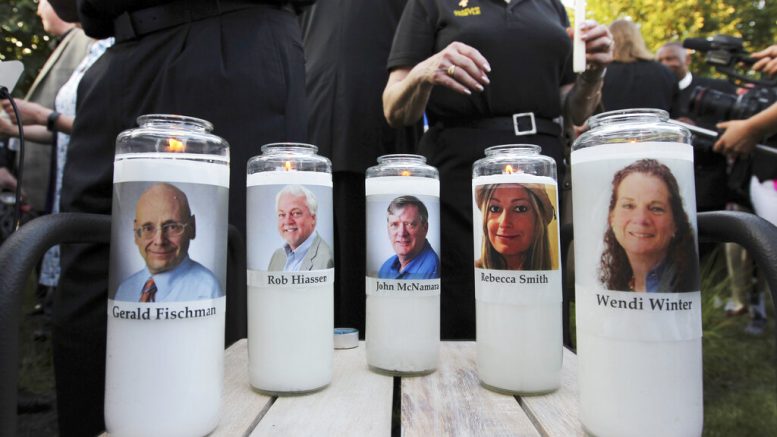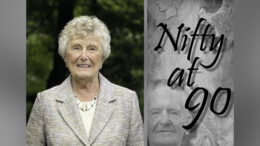ANNAPOLIS, Md. (AP) — Three years after the deadliest attack on a newsroom in U.S. history, residents who were shaken by the assault on their local newspaper that killed five people are hopeful that an end to the gunman’s dragging court case is finally near.
Opening statements in the second phase of a trial are scheduled for Tuesday to determine whether Jarrod Ramos was legally sane at the time of the mass shooting.
Jury selection was completed Friday in the case against Ramos, who called 911 moments after the rampage from inside the newsroom, identified himself as the shooter and said he surrendered. He was later arrested lying face down under a desk.
Ramos pleaded guilty to all 23 counts against him in October 2019, but he is contending he’s not criminally responsible due to mental illness.
Ray Feldmann, who knew some of the victims as well as survivors, remembers driving out of his neighborhood on June 28, 2018 and seeing a swarm of police and emergency vehicles converged around the newspaper’s office, blocks from his home. Now, he says the attack lives in his memory with a magnitude comparable to his recollections of historic events like the 9/11 attacks and the assassination of President John F. Kennedy.
“It’s just hard,” Feldmann said in a recent interview. “The three-year anniversary is coming up in a few days, and there still hasn’t been a trial. I think it does weigh on people.”
The difficulty of the case was evident during jury selection, as potential jurors described how hard it would be to view evidence, while others described connections they had with their local newspaper.
Juror 14 sobbed in court, as Judge Michael Wachs asked her follow-up questions after she indicated she would have trouble watching a video recording during the trial of the attack inside the newsroom that shows victims being shot.
“I cannot handle it,” she said through a mask, choking up in court, before the judge dismissed her from the jury pool.
Juror 27 spoke of how she had met Wendi Winters, a reporter who was one of the five killed. Winters wrote a weekly column focusing on a student at a school in the community. Before being dismissed from the jury, juror 27 described how she used to take children to the newspaper for photographs, and had been troubled by thoughts of what it would have been like to have been at the newspaper at the time of the shooting.
John McNamara, Gerald Fischman, Rob Hiaasen and Rebecca Smith also died in the attack.
“This hurts,” said Donna Cole, a longtime local journalist in Annapolis who used to write for the newspaper and knew Winters. “This hurts the community. This hurts people that didn’t know any of these people. The entire community was impacted by this mass shooting. We want to see justice served.”
The case is happening as the newspaper is going through a transition with a new owner, New York-based hedge fund Alden Global Capital. Rick Hutzell, the former editor, recently volunteered for a buyout and left the paper this month.
The second part of the trial was initially set for November 2019, but Ramos’ lawyers were granted a postponement. The defense contended they had not received adequate information about what experts for prosecutors intended to tell the jury. The trial was delayed again in February 2020 after one of Ramos’ three public defenders left the case for medical reasons, pushing it to June 2020. The pandemic delayed it further.
Steuart Pittman, the county executive, said of the court case: “people want to be done with it.”
“I know that it’s been difficult for the people closest to the tragedy, the families of the victims, people at The Capital newspaper, our first responders who were there, and really everybody,” Pittman said. “It’s been difficult to have this hanging over everybody’s head.”
The judge estimated the case will last 10 business days. He said during jury selection a “vast majority” of the case will consist of testimony from mental health experts called by defense attorneys and prosecutors.
“It’s going to come down to the battle of the experts to a certain extent,” said Ross Suter, senior vice president of litigation solutions for Magna Legal Services.
Under Maryland’s insanity defense law, a defendant has the burden to show by a preponderance of the evidence that he is not criminally responsible for his actions. State law says a defendant is not criminally responsible for criminal conduct if, because of a mental disorder or developmental disabilities, he lacked substantial capacity to appreciate the criminality of his conduct.
If Ramos were found not criminally responsible, he would be committed to a maximum-security psychiatric hospital instead of prison. Prosecutors are seeking life without possibility of parole.
Ramos, 41, had a well-documented history of harassing the newspaper’s journalists. He filed a lawsuit against the paper in 2012, alleging he was defamed in an article about his conviction in a criminal harassment case in 2011. The defamation suit was dismissed as groundless.








































